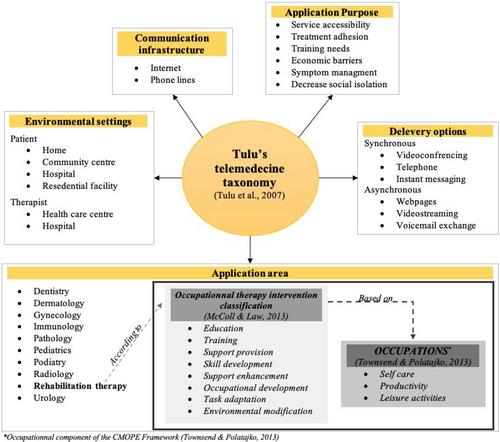Telehealth interventions in occupational therapy with older adults: Results from a scoping review targeting better health promotion
Abstract
Introduction
Telehealth interventions have the potential to enhance access to care and improve efficiency while reducing the burden on patients. Although telehealth interventions are well accepted and adopted in physical therapy, their usage in occupational therapy for older adults is less common, and limited information exists regarding their setting and context.
Objective
To provide an inventory and synthesis of telehealth interventions in occupational therapy for older adults.
Method
For published studies on telehealth-based occupational therapy interventions in older adults between 2000 and 2022, six databases were reviewed. Data extraction and analysis were guided by the taxonomies developed by Tulu, McColl and Law and informed by the Canadian Model of Occupational Performance and Engagement.
Findings
Twenty-three studies on telehealth interventions in occupational therapy for older adults were identified, mostly from North American authors (n = 11; 47.8%) and randomised clinical trials (n = 9; 39.1%). Most participants had a health problem (n = 20; 87.0%), mainly stroke (n = 9; 39.1%). Interventions focussed primarily on symptom management education (n = 12; 52.2%) of community-dwelling adults with health conditions, using videoconferencing systems or applications (n = 14; 60.7%). Interventions were delivered from the healthcare centre (n = 6; 26.1%) to the person's home (n = 18; 78.3%) synchronously (n = 19; 82.6%). About one third (n = 8; 34.8%) of the studies specified the therapist's location.
Conclusion
Published studies on telehealth interventions in occupational therapy with older adults have mainly focussed on the synchronous training and education of participants using videoconferencing systems or applications. According to these studies, the scope of interventions is limited and could be expanded, for example, through occupational development and environmental modification. To better understand and describe best practices in the use of telehealth in occupational therapy, future studies should provide more details about the interventions performed, the technology used and the environmental settings of the therapist.


 求助内容:
求助内容: 应助结果提醒方式:
应助结果提醒方式:


